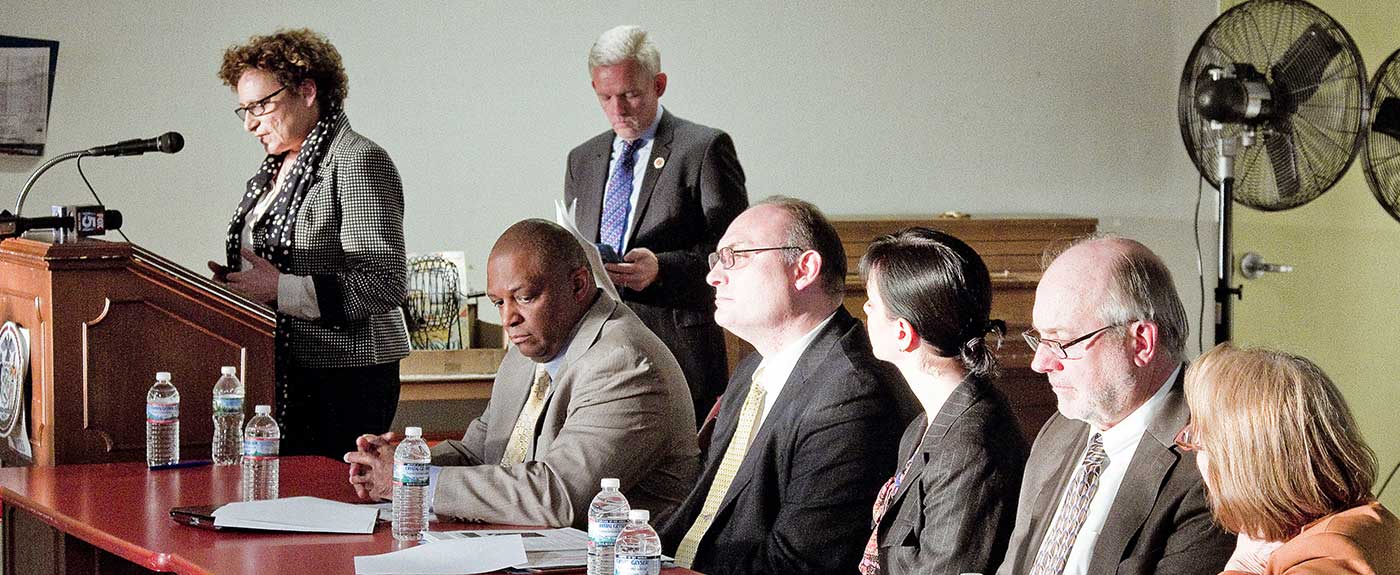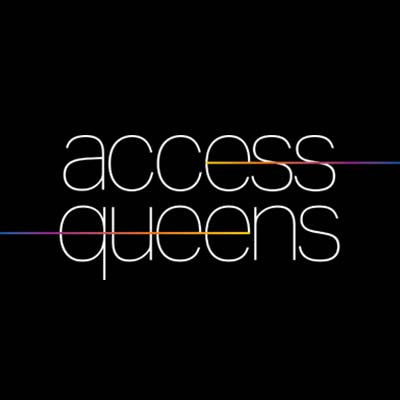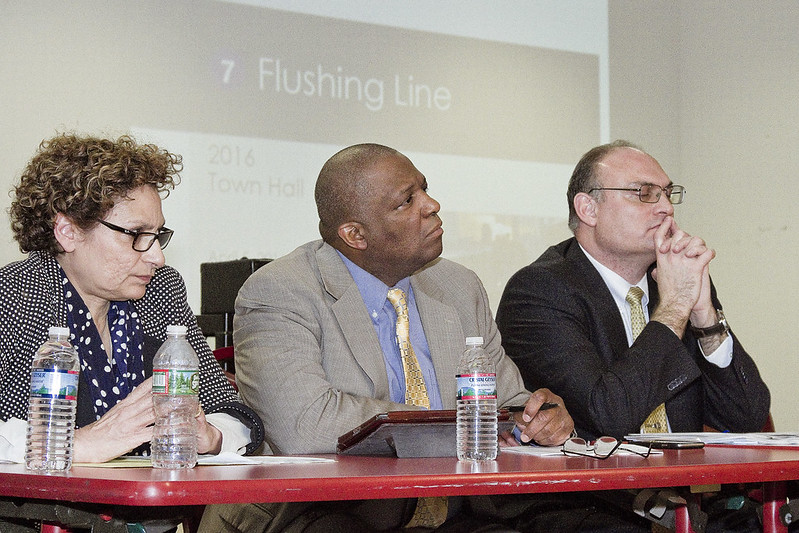On April 5, 2015, Councilman Jimmy Van Bramer and Access Queens hosted a town hall at the Sunnyside Community Services Center to a full house with more than 100 residents and commuters.
Newly-appointed MTA New York City Transit President Veronique “Ronnie” Hakim joined the panel discussion along with other MTA officials, Wynton Habersham, Senior Vice President of the Department of Subways; Gary Greenblatt, Manager, Supply Chain Operations; John O’Grady, Senior Vice President of Capital Program Management; and Judy McClain, Senior Director of Service Planning.
Media outlets held the perimeter of the hall. Among them was NY1, Pix11 News, Univision, NBC New York, 1010 Wins, Good Day NY, and local papers Sunnyside Post, Gothamist, Daily News and amNY. Articles from these outlets and more can be found here.
Opening remarks were given by Van Bramer, followed by Melissa Orlando, Founder & Executive Director of Access Queens. You can read her remarks here. Hakim took to the podium with further remarks and gave a presentation on the status, progress and future of the 7 Train.
Following the presentation was a Q&A session with questions alternating between the ones submitted online and ones taken live at the event. Residents held their cool, though several were visibly frustrated. However, the town hall was informative and a step in the right direction toward opening dialog.
“We are not a community of discretionary riders,” Hakim said. “We want to listen and provide answers when we can.” Hakim stressed that ongoing projects like replacing miles of aging track, repairing the Steinway Tube post Superstorm Sandy damage, and the new Communications-Based Train Control (CBTC) signal system, are all each nearing completion. CBTC is supposed to speed up service and bring countdown clocks to the platforms, granted, testing and refinements will need to occur in the months before and after it’s installed.
Read on for more of the event’s highlights. You can download the MTA’s presentation (PDF) here. A full transcription of the event will be available later this week.
The big take away for the MTA is to improve communication. Residents seemed understanding of the challenges in old equipment, high population demand and damage done by Superstorm Sandy, but a few offered solutions or posed new transportation issues that the MTA nor us expected.
As for the rest of us, we need to be patient while equipment upgrades are completed, but continue to speak up to make sure our needs are heard and addressed.
Interesting Facts
- A $774 million capital improvement is required to replace the aging signal system. Work is expected to be completed at the end of 2017.
- Each 7 Train carries has a 1,200-passenger capacity. 27 trains run in each direction per hour during weekday peak time.
- 7 Trains carry 525,000 riders a day on average and make 622 trips across the line every day. Ridership drops to 350,000 on Saturdays and to 300,000 on Sundays. It is tied with the 6 for the most frequency of service throughout the entire system.
- The N and Q trains (according to McClain) are currently at capacity. The E and F lines are also quite crowded, but there is some capacity on the R and M trains.
- McClain stated that they have urged the Department of City Planning to focus on the areas and lines where capacity is available.
- Hakim said increased subway service is just one of many solutions to the transportation needs in the area. Select Bus Service and bus rapid transit were among the solutions.
- Van Bramer said that there would be no rezoning — referring to Queens Plaza/Court Square — without transportation options increasing.
- Greenblatt stated that of the 65 past Mondays (assuming from the town hall), the MTA has 55 recorded with good service performance.
MTA’s Challenges
- Aging "fixed block signal systems" are 100 years old and aging track panels (with a 25-year lifespan, some more than 30 years old) are both significant causes of delays.
- The MTA faces street impacts that require coordination with the Department of Transportation.
- There are several bottlenecks: 33rd-Rawson Street (where the line drops from three to two tracks and where local and express services must share right of way); the Steinway Tubes (where there is no clearance for workers while trains are running, hence the closures); and other areas that have a two-track segment.
- Water and rail conditions in the Steinway Tubes pose southbound service challenges that the MTA is currently addressing. Weather in general is a major challenge.
- The express train is at capacity. The key load of passengers occurs before Queensboro Plaza (assuming in both directions).
MTA's Accomplishments (So Far):
- Based on ridership data, two evening trains were added in 2015.
- The number of service outages is expected to decline. In 2013, service was down for 17 weekends. The number of outages was cut down to eight in 2016.
- 94% of the track panels will be within their anticipated lifespan by the end of 2016. This work is near completion overall.
- April 23, 2016 was said to be the day of reconstruction, rehabilitation and fortification of the Steinway Tubes (presentation says end of the month). $41 million was spent on this work.
- WIFI and cell service is now available at every station as part of a bigger plan to utilize technology. More on-the-go kiosks for riders to receive updates and alternate travel information are part of the capital plan.
- The MTA is creating Combined Action Teams (CAT) that will increase inspections and identify defects before they happen. They will also be stationed along the line to address issues as they happen for a faster response rate.
- 16 stations have help points installed. Help points will be installed in six more stations in 2017.
MTA’s Future Plans
- Weekend closures between Long Island City and Manhattan will continue until the end of 2017.
- Installation of 3rd rail heaters at Queensboro Plaza, 33rd Rawson, 52nd Street, 61st Street, and the track section south of Main Street will reduce impact of ice and snow.
- The CBTC system is scheduled for completion sometime at the end of 2017. As such, countdown clocks will follow at that time.
- The MTA will re-examine ridership data and make a recommendation for two additional evening trains for 2016.
- Structural painting contracts for 72nd Street to 103rd Street will be awarded in 2017. 48th Street to 72nd Street contracts will be awarded in 2019.
More details about future work can be found in the MTA’s presentation.
The MTA Committed to Looking Into:
- Rapid deployment of information, including on social media.
- Cross-honoring rides on the LIRR. Free fare compensation will have to be brought to the board level for discussion.
- Increasing Q103 service (currently runs once or twice an hour) to take riders to the 21st Street-Queensbridge F train, which is about a 10-minute ride from the bus’s Vernon Boulevard-Borden Avenue stop.
- Working at the reliability of service.
- Sharing information between the community and the MTA.
A full transcription of the event will be available later this week as well as other follow-up to the town hall.


